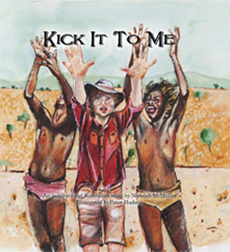Tom is unhappy as cricket season has ended. To cheer him up his friend Jirra invites him back to the Djab Wurrung camp to play a game Jirra calls Marn-grook telling Tom he will teach him how to play.
Many children join in as Jirra grabs the ball, runs, stops and spins to face them. He holds the ball in two hands over his left foot before dropping it on his foot and kicking it hard and high into the sky. It shoots off to the right and everyone chases it, all trying get there first. When Tom gets the ball, he kicks it far and high and is amazed when one of the boys leaps high in the air, his knees riding on Jirra’s shoulders. To Tom he appears to hover, perfectly balanced as he reaches and grabs the ball. They play on, running, dodging, weaving, kicking and leaping for the ball. Tom loves this awesome new game and the prospect of playing it with his friends.
Both the text and the illustrations create a sense of carefree excitement. Peter Hudson’s strong and lively illustrations have a directness that shares with the reader the energy and joy of the boys. You can’t help but smile at their exuberance.
This story is set in 1846 and tells of Tom Wills who lived with his family on Djab Wurrung country in Western Victoria. He became friends with the local Djab Wurrung children, learning their language and being taught to play their game Marn-grook football. Tom Wills went on to become a champion sportsman in both England and Australia. In 1858, he pioneered in Melbourne a new football code called ‘Australian Rules’ based on the exciting game he had played as a child called ‘Marn-grook’.
At the back of the book is a short biography of Tom Wells and an explanation of the meaning and relevance of the Indigenous words used in the book. The forward is written by former Collingwood Football Club President, Eddie McGuire.

